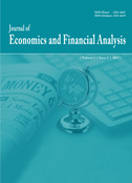URI: https://ojs.tripaledu.com/jefa/article/view/36/35
Factors Influencing Cryptocurrency Prices: Evidence from Bitcoin, Ethereum, Dash, Litecoin, and Monero
DOI: http://dx.doi.org/10.1991/jefa.v2i2.a16
Abstract
Lastly, error-correction models for Bitcoin, Etherem, Dash, Litcoin, and Monero show that cointegrated series cannot drift too far apart, and converge to a long-run equilibrium at a speed of 23.68%, 12.76%, 10.20%, 22.91%, and 14.27% respectively.
Keywords
JEL Classification
References
Bouoiyour, J., and Selmi, R. (2016). Bitcoin: A beginning of a new phase? Economics Bulletin, 36, 1430–40.
Brill, A., and Keene, L. (2014). Cryptocurrencies: The Next Generation of Terrorist Financing? Defence Against Terrorism Review, 6(1), 7-30.
Chiu, J., and Koeppl, T. (2017). The Economics of Cryptocurrencies - Bitcoin and Beyond. Bank of Canada.
Chu, J. Chan, S., Nadarajah, S., and Osterrieder, J. (2017). GARCH Modelling of Cryptocurrencies. Journal of Risk and Financial Management, 10 (17), 1-15. doi:10.3390/jrfm10040017
Dyhrberg, A. (2016). Hedging capabilities of Bitcoin. Is it the virtual gold? Finance Research Letters, 16, 139–44.
El Bahrawy, A., and Alessandretti, L. (2017). Evolutionary dynamics of the cryptocurrency market. Royal Society Open Science, 4(170623), http://dx.doi.org/10.1098/rsos.170623
Katsiampa, P. (2017). Volatility estimation for Bitcoin: A comparison of GARCH models. Economics Letters, 158, 3–6.
Letra, I.J.S. (2016). What drives cryptocurrency value? A volatility and predictability analysis. Available online: https://www.repository.utl.pt/handle/10400.5/12556 (accessed on 15 December 2017).
Nakamoto, S. (2008). Bitcoin: A Peer-to-Peer Electronic Cash System. Unpublished manuscript. Retrieved at http://pdos.csail.mit.edu/6.824/papers/bitcoin.pdf.
Newey, W., and West, K. (1987). A Simple, Positive Semi-definite, Heteroskedasticity and Autocorrelation Consistent Covariance Matrix. Econometrica, 55(3), 703-08.
Pesaran, M.H., Shin, Y., and Smith, R.J. (2001). Bounds Testing Approaches to the Analysis of Level Relationships. Journal of Applied Econometrics, 16(3), 289-326.
Polasik, M., Piotrowska, A., Wisniewski, T.P., Kotkowski, R., and Lightfoot, G. (2015). Price Fluctuations and the Use of Bitcoin: An Empirical Inquiry. International Journal of Electronic Commerce, 20(1), 9-49
Poyser, O. (2017). Exploring the determinants of Bitcoin’s price: an application of Bayesian Structural Time Series. Dissertation.
Schwarz, G.E. (1978), Estimating the dimension of a model. Annals of Statistics, 6(2), 461–464, doi:10.1214/aos/1176344136.
Sovbetov, Y., and Saka, H. (2018). Does it take two to tango: Interaction between Credit Default Swaps and National Stock Indices. Journal of Economics and Financial Analysis, 2(1), pp. 129-149.
Yermack, D. (2013). Is Bitcoin a real currency? An economic appraisal. NBER Working Paper Series, No: 19747. doi:10.3386/w19747

This work is licensed under a Creative Commons Attribution-NonCommercial-NoDerivatives 4.0 International License.


